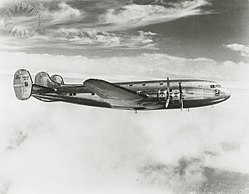Douglas DC-4E
| Douglas DC-4E | |
|---|---|

|
|
| Type: | Passenger plane |
| Design country: | |
| Manufacturer: | |
| First flight: |
June 7, 1938 |
| Number of pieces: |
1 |
The Douglas DC-4E was a large four-engine passenger aircraft from 1938, where "E" stands for " experimental ". The pattern has nothing to do with the later Douglas DC-4 / C-54.
history
The airline United Air Lines had the Douglas Aircraft Company in California's Santa Monica given the order to develop a long-haul aircraft, which can fly with only one stopover from coast to coast of the United States should. This development was funded by United Air Lines , Transcontinental and Western Air ( T&WA ), Eastern Air Lines , American Airlines and Pan American Airways ( Pan Am ), which paid a total of $ 1.634 million. As with the Lockheed Constellation , a triple arrangement of the vertical stabilizer was chosen so that the machine can be accommodated in halls of normal height. The DC-4E flew after 18 months of construction on June 7, 1938. The flight tests did not result in any significant problems. However, the machine was soon seen as too large for the needs of the airlines, whereupon Douglas concentrated on building the later DC-4.
Basis for a heavy Japanese bomber
The Japanese Navy had long considered building a heavy long-range bomber . Since the Japanese aircraft industry lacked experience with a modern aircraft of this size, they looked abroad. At the end of 1939, the only DC-4E ever built was sold to the Japan Airways Company , which immediately gave it to the Japanese Navy and Nakajima . The machine was carefully examined and served as the basis for the long-range bomber Nakajima G5N. A similar procedure had already been used by Mitsubishi in 1932 with the Junkers K 51 / Ki 20 . However, the American construction first had to be transferred to the metric system .
Six prototypes were created. The wings and landing gear were taken over almost unchanged, the fuselage adapted to the tasks of a bomber and the central vertical stabilizer omitted. The first flight of the G5N took place on April 8, 1941. The drive was initially carried out by Nakajima NK7A “Mamori” engines, then from No. 3 onwards by four more reliable double star engines Mitsubishi MK4B 12 “Kasei”. Engines in the 2000 hp class as in the comparable Boeing B-29 , however, were not available. As a result, the performance remained disappointing and the machines were used as transporters. The variants Ki-68 and Ki-85 intended for the army were not built.
In 1942 the Imperial Japanese Army started “Project Z”. This should produce an intercontinental bomber similar to the German America bomber , which should reach North America from Japan. Designs were submitted to the Imperial Japanese Army by Kawasaki and Nakajima . The company Nakajima was finally selected to design a six-engine bomber of the dimensions of the later Convair B-36 , as they had gained experience in large aircraft construction based on an already flying and tested model. However, there were still no sufficiently powerful engines available for the G10N design. In July 1944, "Project Z" and other projects to develop super-heavy bombers were canceled and Nakajima designed the smaller G8N "Renzan" bomber . This corresponded in its dimensions to the Boeing B-17 or Consolidated B-24 .
Technical specifications
| Parameter | Data |
|---|---|
| crew | 3 |
| Passengers | 42 |
| length | 29.74 m |
| span | 42.14 m |
| height | 7.48 m |
| Wing area | 200.2 m² |
| Wing extension | 8.9 |
| Empty mass | 19,324 kg |
| Takeoff mass | 27,921 kg |
| Cruising speed | 322 km / h |
| Top speed | 349 km / h |
| Summit height | 7000 m |
| Range | approx. 3500 km |
| Engines | 4 × 14-cylinder double radial engines Pratt & Whitney R-2180 -S1A1-Twin Hornet, each 1,450 PS (approx. 1,070 kW) |
literature
- Mike Hardy: Douglas Commercial Four - DC-4E: forerunner of a long line of Douglas four-engined transports . In: Airplane Monthly, March 1995, pp. 10-15
- Mike Hardy: Douglas Commercial Four - DC-4E: data for a four-engined bomber for the Imperial Japanese Navy . In: Airplane Monthly, April 1995, pp. 43-46

